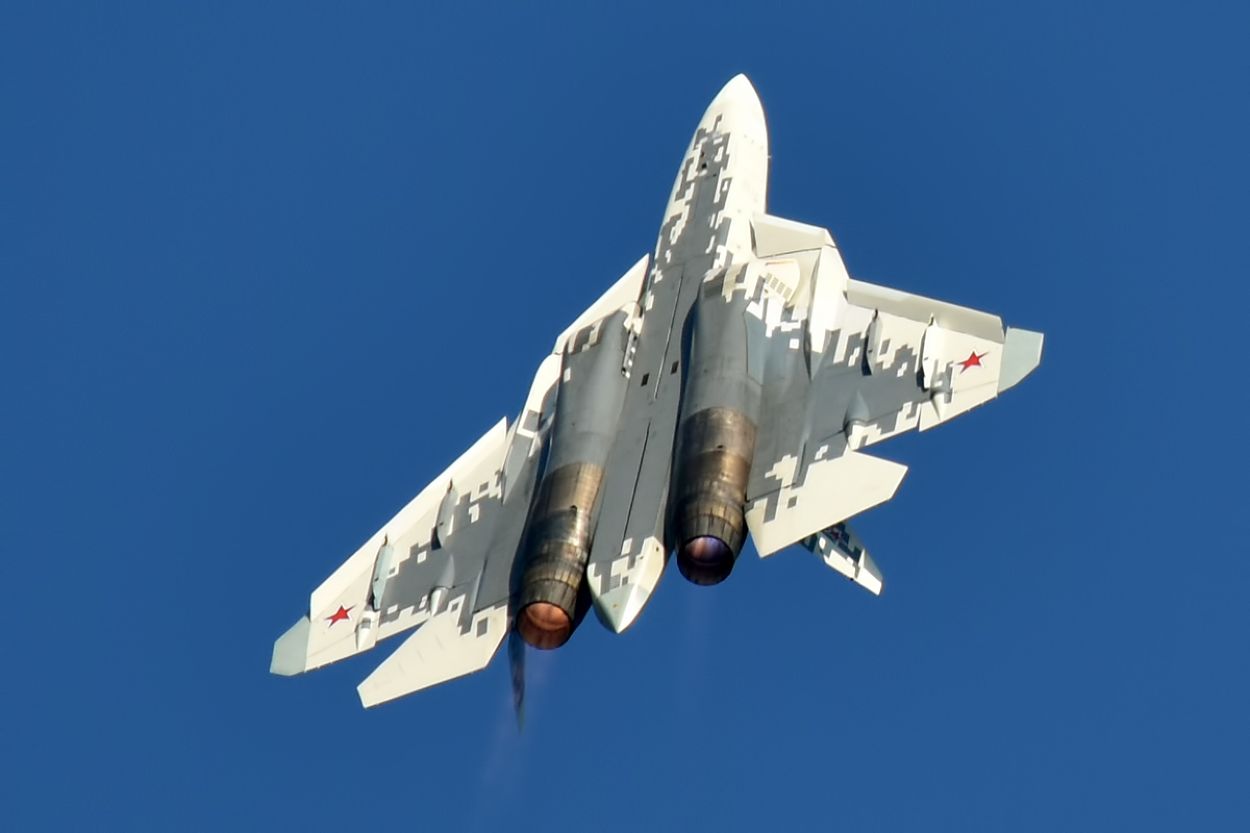Russia doubles production of Su-57 aircraft; Ukrainian F-16s are likely to face the wrath of RuAF stealth jets » Today Latest Stories

On 27 December 2023, UAC delivered the final batch of fifth-generation Su-57 fighters to the Russian Ministry of Defense (RuMoD) within the framework of the 2023 production programme.
Kh-47M2 hypersonic missile: Claims of Ukrainian Kinzhal missiles being shot down by Patriot missiles are all false: OPED
In 2023, UAC strengthened its Su-57 production capacity and improved the aircraft’s assembly line. It has eliminated bottlenecks, not only in the final assembly shop but throughout the entire production cycle.
The process of purchasing high-tech components from supplier factories was simplified, and aircraft assembly technology began to be improved.
In a statement to the press service of the Ministry of Industry and Trade of the Russian Federation, Sergei Chemezov, CEO of Rostec, said: “In the final assembly shop, work is already underway on combat vehicles that will be transferred to the Russian Aviation Authority.” troops in 2024. The number of fifth-generation fighters entering the army almost doubles every year.
The statement indicated that in 2024, Rostec will double its production.
Current and future inventory
During Army 2019, UAC and RuMoD signed a contract for the supply of 76 Su-57 fighters to the Russian Aerospace Forces as part of the state armament program until 2027.
Based on previous reports in Russian media, here is an attempt to extrapolate the time frame within which Rostec will be able to fulfill the contract after the production ramp-up that begins in 2023.
On November 22, 2019, Rostec announced, through a press release, that its subsidiary ONPP Technologiya will supply Sukhoi with 74 sets of installed equipment from 2020 to 2028 for the production of Su-57 fighters.
Before the start of the Special Military Operation (SMO) on 24 February 2022, the Su-57 was in low initial rate serial production (LIRP), which was planned to be upgraded in a phased manner.
In November 2020, a source told TASS that the Su-57 production rate would eventually grow to 15 aircraft per year. In August 2020, Izvestia reported that full production rate would be achieved by 2024.
In November 2021, Izvestia reported that “in December, four Su-57 fighters will be transferred to the Russian Air Force from the Komsomolsk-on-Amur Aviation Plant.”
The report added that with the delivery of a new batch of aircraft, the number of these fighters in the armed forces will reach five units. According to one report, the Russian Air Force received one Su-57 fighter in 2020 and three in 2021, for a total of four. Suppose this report was correct.
As of December 2022, Rostec’s subsidiary United Aircraft Corporation (UAC) has delivered 10 Su-57 fighters. This means that UAC delivered 6 aircraft in 2022, which is twice the number of aircraft delivered in 2021.
Ahead of Army 2023, Vladimir Artyakov, First Deputy Director General of Rostec, told Izvestia that Russia plans to significantly increase the Su-57 production rate. It is possible that Rostec is now striving to achieve the maximum production rate earlier than planned.
According to the latest statement from the Ministry of Industry and Trade of the Russian Federation, Rostec is likely to deliver 12 Su-57 fighters in 2023, bringing the total number of aircraft delivered to 22. Rostec is also scheduled to achieve full rate production of 15 aircraft. Annually in 2024
year | Su-57 delivered |
2020 | 1 |
2021 | 3 |
2022 | 6 |
2023 | 12 |
2024 | 15? |
Based on the above extrapolation, by the end of 2024, the Russian Air Force will have 37 Su-57 fighters. According to the original production plan, the total number of production at the end of 2024 was 24.
Assuming a production rate of 15 aircraft per year from 2024 onwards, RuMoD’s order for 76 aircraft will be met well before the end of 2027.
Operational importance
It is very likely that until now, the Russian Air Force has used its Su-57 fighters exclusively for operational testing, tactical development and training. With 22 aircraft in its inventory, the Russian Air Force now has the numbers necessary to begin raising its first operational regiment of Su-57 fighters.
Assuming that approximately 8 fighters will continue to be deployed for operational testing and tactical development, some of them will likely be available for combat operations.
With an additional 15 fighters added to the Russian Air Force’s inventory in 2024, the number of stealth fighters available for operational deployment will increase rapidly.
The Ukrainian Air Force (UAF) will begin to feel the impact of the Su-57 deployment in the coming months.
The following paragraphs address the potential operational impact of the Su-57.
Dark mode operations
The Su-57 operates in dark mode, keeping its radar and other radio frequency emitters off to avoid passive detection by an adversary while using its stealth form to avoid radar detection.
The Su-57 has good front-side stealth – almost as good as the F-22 Raptor. As a result, the Su-57 will be able to operate close to the battlefront, undetected by Ukrainian air defense (AD) radars, compared to RuAF fourth-generation fighters such as the Su-35S.
While it may be possible for the AN/MPQ-65 search radar of the US Patriot AD system located near the Ukrainian battlefront to detect a RuAF Su-34 operating 100 km behind the battlefront, it would not be possible for US radar to detect Su-57 aircraft 25 km behind the battlefront.
Importantly, the Su-57 would detect radio emissions from the AN/MPQ-65 before the AN/MPQ-65 detected reflected emissions from the Su-57, even when the US radar was operating at Low Probability of Interception (LPI). ) situation.
Once the Su-57 detects radar emissions, the radar coordinates will be transmitted via a secure data link to the Kh-31P anti-radiation missile armed with the Su-35S or Su-34, which operates well behind the battlefront, out of AN/MPQ detection range. -65.
As a result, the AN/MPQ-65 would be destroyed before the Patriot system had a chance to fire its PAC-3 interceptor missile at the Su-57.
The possibility of NATO AWACS planes providing direct data to the Patriot missile launch radar (MFR) would also be minimal. Even for AWACS aircraft, the detection range of the Su-57 would be much lower. Moreover, NATO AWACS aircraft, for their own safety, must operate from outside Ukrainian airspace.
Long-range hidden missiles and bombs
Unlike the F-22 Raptor, which is designed to penetrate contested airspace and strike targets with short-range precision-guided munitions (PGM), the Su-57 is designed to approach contested airspace and strike targets with long-range PGMs, including missiles. Which cannot be intercepted due to its stealthy shape or supersonic speed.
Hard-to-intercept cruise missiles include the Kh-69, a stealth version of the Kh-59Mk-2, with a range of 290 km, and the Gremlin (Product 70) hypersonic missile with a range of 1,500 km and a speed range of Mach 6.
The Gremlin will be powered by the Production 70 turbojet engine developed by Soyuz TMKB (Turaevskoe Machine-Building Design Bureau). As such, the missile will be able to fly at hypersonic speeds for an extended period.
Long-range non-stealth cruise missiles that can be launched by the Su-57 from close to the battlefront include the Kh-35UE, which has a maximum range of 260 km; The Kh-31PD supersonic anti-radiation missile for use against air defense systems, has a range of 250 km; The Kh-58UShKE missile, designed to destroy pulsed radars, can hit targets at a distance of 245 km.
Currently, Russian strategic aviation and Russian Air Force fighters fire cruise missiles from a distance behind the battlefront. Not only does this reduce the range of missile strikes, but the Ukrainian counterterrorism agency begins tracking missiles long before they enter Ukrainian airspace.
It also makes missile guidance more predictable. All that will change once RuAF Su-57 fighters start firing missiles at close range from the battlefront.

Death spell for Ukrainian F-16 operations
Zelensky and the US Air Force have high hopes for the F-16s provided to them by NATO.
For the UAF, the most important feature of the F-16’s operation is…
Integration with NATO AWACS improves situational awareness
Better integration of NATO weapons such as cruise missiles, glide bombs and AIM-120 air-to-air missiles.
Pose an increased risk to RuAF fighter operations due to the longer range of the F-16 air-to-air missiles
RuAF Su-57s patrolling along the battlefront would negate all the advantages in one fell swoop. Even while operating in dark mode, the RuAF Su-57s will be able to detect and engage NATO F-16s long before the F-16s are alerted to the presence of the Su-57s.
The F-16s will have longer-range AIM-120 air-to-air missiles than the Soviet-era fighters currently used by the UAF, but the Su-57 will have longer-range air-to-air missiles like the RVV-BD.
Conclusion
In 2024, the number of operationally deployed RuAF Su-57s will be large enough – not only to completely negate the deployment of F-16s by the UAF but also to achieve Russia’s SMO objectives without causing Ukraine to unnecessarily lose an additional 100,000 troops as well. Like Odessa and Kharkiv!
- Vijainder K Thakur is a retired IAF Jaguar pilot. He is also an author, software engineer, entrepreneur, and military analyst. Personal views of the author
- Follow the author @fkthakur








